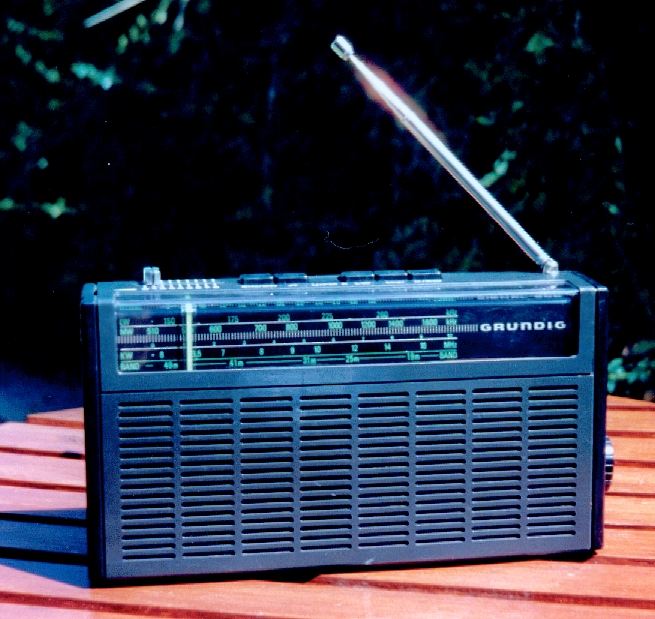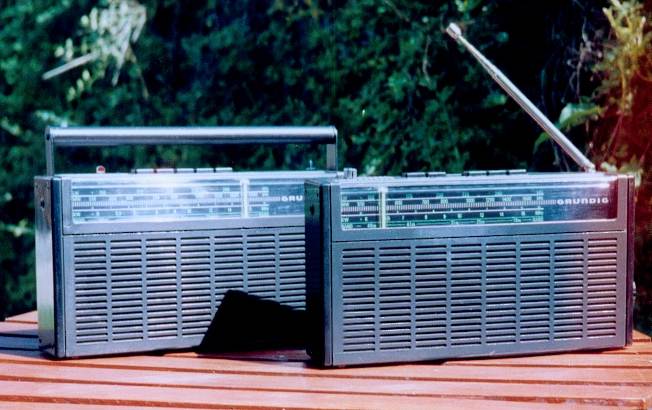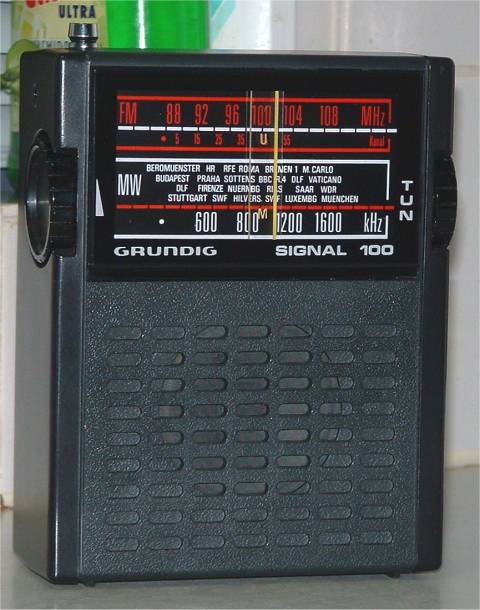



Then, in 1974, things changed. A year or two earlier, a new electrical discount store chain had spread across Britain, the chain was called "Trident" and by not having flashy premises or setting up in high streets where costs were high, they undercut all other electrical retailers by huge amounts. In mid-1974, their weekly Saturday morning national press advert had a new addition, the Grundig Signal 500 E. I rushed round to the local Trident, it wasn't far from my house, and was delighted with what I saw, a 4 waveband radio in Grundig's middle-of-the-road class, but at a much lower price than usual for this level of performance, thanks to the omission of chrome and aluminium trim and so on. It was about £32, a more typical price for this "level of performance Grundig" was £50. Not a big difference by today's standards, but this was the mid-1970's, and I was still only 15 and at school. The other problem was that Trident didn't keep models in stock for a long time, so the race was on to save the required amount up while it was still available.
With a birthday in November, and money for Christmas which I was allowed to get my hands on early, I finally managed to buy the radio on December 24th, 1974. I had a very happy Christmas, with my first multiband radio, bought new, and by my favourite radio manufacturer!
Ultimately, I sold it in 1979 to finance a Grundig C6200 Radio Cassette Recorder, as money was still tight, and you don't realise the significance of things. Many years later, I regretted selling it. Ebay came along, and Signal 500's rarely appeared. Of those that did, the first was not available to those outside the USA, and the second had the tuning knob missing, and other problems. Third time lucky! The one at the top of this page was bought in June 2003 from Ebay ID "sell_sell_sell_now" in Thousand Oaks, Los Angeles, USA. Like both the others before it, the carrying strap, (which was detachable, and plugged into slots in the top) had long gone, and the volume slider was missing, but otherwise it was fine, and had even had a home-made wooden handle made to fit the slots where the strap should fit. Thus it's not perfect, but for a 28 year old radio, it's OK, and was caught for a very reasonable price.
The battery box is totally clean, complete with label with serial # on, and I was surprised to find in there, not only an adaptor container to allow the use of 6 C cells instead of the usual PP9 block battery (These adaptors are £5 (about $8) here Ė I only paid $12.50 for the radio!) but also the 6 C cells! Iíd forgotten, but the battery cover has a diagram showing how to dismantle the radio, and itís in there too, in near perfect shape. The set is the same length and depth as a Sat 700, about half an inch less tall, and the audio from the speaker is better, as it has a 5.5x3.75 speaker. All bands work fine, in fact, the low end of the SW coverage is quoted in the instruction manual (I still have the one from my original set 28 years ago, see that here) as 5850, so I tried it. I tuned the radio to the end-stop, and there was Radio Canada Intíl, confirmed by the Sat 700! How that for alignment stability after 28 years?
After all these years of waiting for a Signal 500 to appear, it seemed mad that the day after the auction for this one ended, another appeared on Ebay.de, the German Ebay site. Though not in such good condition, it had the volume slider knob, so now I have a complete, fully working example, and a spare. The chance of getting a strap are zero, unfortunately. Even the Ebay.de one didn't have that.
It seems there were 5 models in the "Signal" series, the 100, 300, 500, 700 & the 2000 radio cassette recorder, all sharing similar styling cues.
Here are pictures of some of them:


I also like the omission of the "Boy" suffix from this model. Not that I don't like the Boy theme to Grundig radios, but there are few without it, and mostly they are Satellits! (I have seen comments before about people being glad they didn't call them "Satellit Boy") In this case, it just makes the model seem "a bit different". Incidentally, although the script on the radio itself says "Signal 500", all the documentation and the type plate on the bottom of the set say "Signal 500 E". What the "E" stands for I don't know. Not "Europe" as far as I can tell, as the one I have from the USA also says "500 E" on the type plate, (even though the safety regulation marks are different from the European version) and covers all AC voltages. The Signal 500 E does not need switching between 110 & 240 V, it does it itself!
Size: 168mm high x 290mm wide x 66mm deep.
Weight (excluding batteries): 2.0 kg.
Power supply:
Tuning options:
Tuning meter: No.
Local/DX switch: No.
Aerials: Ferrite rod for LW & MW, Telescopic for FM & SW.
Dial illumination: No.
Mono selector: No (mono only).
Sockets:
Tone control: Treble switch.
Clock/Timer: